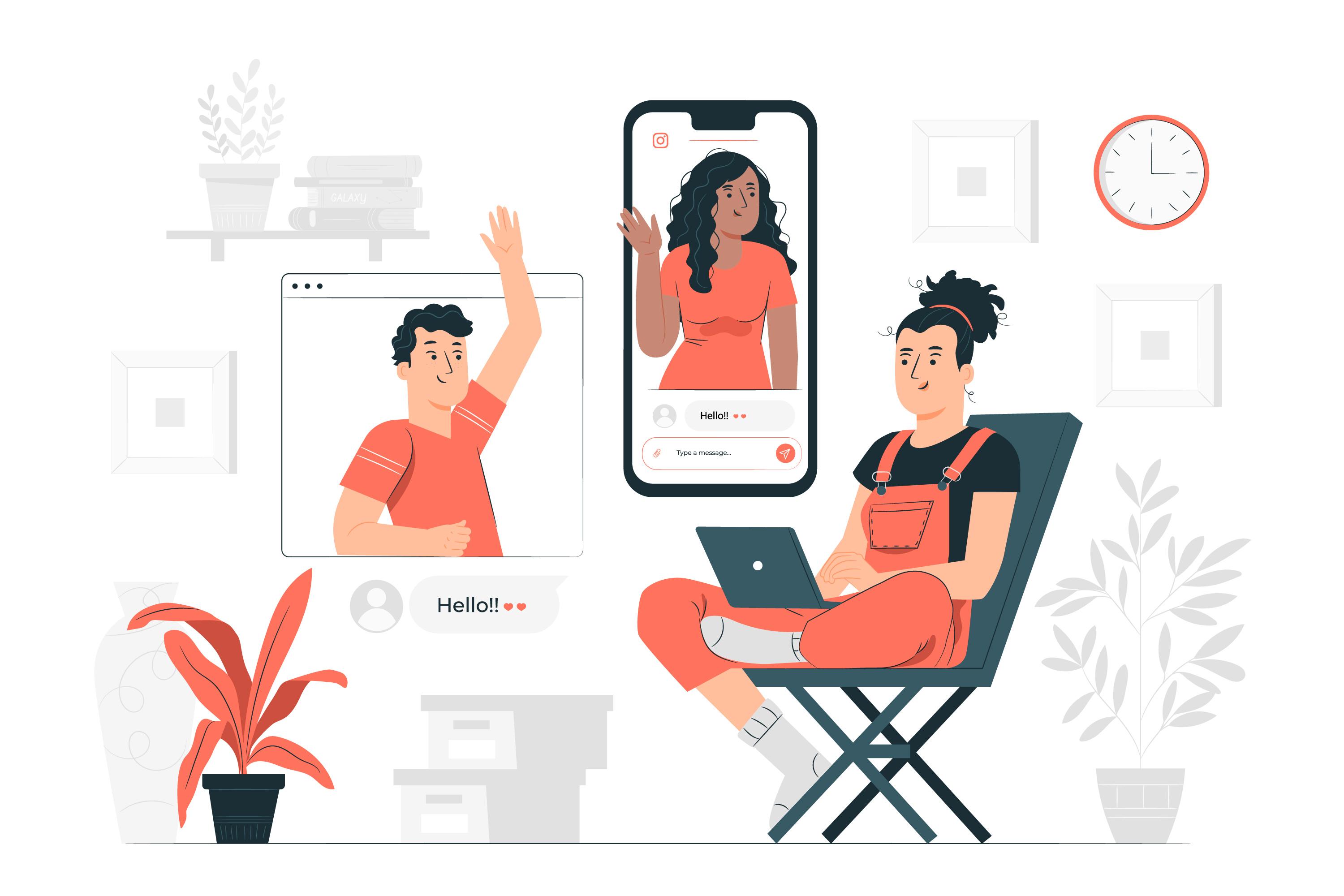The past 10 months have been unprecedented for everyone around the world, and socially, younger people haven’t established their social circles yet, whether they’re transitioning from education systems to the “real world” or growing out of friend groups.
During this time, it can be difficult to create new friendships since many continue trying to be safe from the Coronavirus. Unbeknownst to many, though, many young people have been creating friendships online for years. Although “don’t talk to strangers” is a common motif in many societies, the social media generation has branched out of that way of thinking and found ways to create and foster human connection safely across continents through the internet.
Earlier during the pandemic, developers named Danielle Baskin and Max Hawkins launched QuarantineChat, a platform that connects people from around the world to chat at specific times of the day. Many have found that it kept them company to speak to strangers during the pandemic when communication with the outside world is limited. The app was popular in Iran, Hong Kong, Portugal, and London.
While such apps have not grown in popularity in Egypt, basic social media apps have been serving the same purpose since before the pandemic, and especially during. Twitter and Facebook, in particular, have been places for like-minded people to meet and bond over similar interests or points of view.
Farida Ezzat, for example, is a 25-year-old who says she met her best friend on Facebook six years ago.
“The entire relationship has been mostly virtual although we jumped on multiple platforms like Telegram and Discord. We’ve been through a lot over the years which can be hard when we can’t be together in real life,” Ezzat told Egyptian Streets.
It’s been especially difficult for them to get together in person because Ezzat has been in Turkey for the past six years, while her friend is in Egypt. Now, they’re finally in the same country and have met in-person but with COVID-19 their friendship remains mostly online.
“Online relationships can be difficult for some but for me, I found it very advantageous especially that I’m an introvert and feel more comfortable with virtual interactions. I’m glad I met someone I can be myself around and the same applies to my friend too,” she adds.
How did Ezzat and her friend meet? On a Facebook group called Awesome People Who Discuss Awesome Stuff, “Yes, it’s true,” she says.
Ahmed Omar*, 22, says that one of his closest friends — who he describes as his soulmate — is someone he has never met. He explains that they often talk over the phone, using video chats, and across social media platforms, which makes up for the distance.
“My soulmate lives in Florida. I’ve known him since 2015 and I haven’t seen him in person once, it was all through the internet,” Omar says. “He was in my old school, I came after he left. A lot of my classmates told me I was like him. Obviously, we had lots of mutual friends on Twitter. If I recall correctly I think he followed me then asked about a tweet I wrote, then we started talking. And the rest, as they say, is history.”
POST-OUTBREAK FRIENDSHIPS
Some of those who weren’t as actively social online have started to avidly use social media to meet new people during the pandemic as an alternative to in-person communication.
As for younger teens, the Children’s Hospital of Chicago reports that 63% of parents surveyed says their teen’s social media use increased during quarantine.
Zeineldin Elkhabiry, 22, hadn’t been actively seeking out socialization with people outside his in-person social circles prior to the pandemic, and he explains that it more so happened to him rather than was intentional.
“Once I actually started getting to know people I realized it was a very good way of making friends. Especially in a time when in-person interaction is not very easy. It was really a snowball effect, as I keep going the more friends I make,” he says.
Elkhabiry does not think he would have created the same friends if there was not a pandemic that forced people to stay home.

“It was more or less a substitute, so since I couldn’t meet people in person I thought, why not online? Especially that between most of them I have a lot of mutual friends, so it’s not like they’re complete strangers, I can still figure out who they are,” he says. “I meet friends mostly through Twitter, it was about March when I actually started going back on Twitter. It starts with me following them or them following me, usually through interactions on people’s tweets we have in common.”
Unlike others, though, Elkhabiry doesn’t extensively use virtual communication platforms that entail audio or video communication as much and prefers text.
“I usually wait until the other person initiates when it comes to calls, in general. It’s because I generally prefer text that I feel that others won’t prefer calls. It’s more pressure to keep the conversation going, as opposed to if you’re texting you can just disappear for a few minutes and it would be completely normal,” he told Egyptian Streets.
He maintains the opinion that his friendships still hold true to their closeness, despite the lack of audio-visual interaction.
The Touch Pandemic
In the past several months, more and more research has been conducted on the importance of touch, proving that touch deprivation has become highly influential to the status of people’s mental health during this time.
An article from The New Yorker in 2015 that examined the status of friendships in the social media era states, “With social media, we can easily keep up with the lives and interests of far more than a hundred and fifty people. But without investing the face-to-face time, we lack deeper connections to them, and the time we invest in superficial relationships comes at the expense of more profound ones.”
Does this fully apply in the era of the pandemic? If the amount of social capital one has, according to University of Oxford anthropologist and psychologist Robert Dunbar, is fixed, then when the decrease of in-person socialization and friendship caused by the pandemic is a factor, social-media-based friendships have more room to flourish.
However, the element of touch is still pervasive in the creation of bonding, Dunbar says. “We underestimate how important touch is in the social world, with a light brush on the shoulder, a pat, or a squeeze of the arm or hand, we can communicate a deeper bond than through speaking alone. Words are easy. But the way someone touches you, even casually, tells you more about what they’re thinking of you,” he says.
A study from The Royal Society examined pain thresholds by seeing how long a person could keep their hand in a bucket of ice water. It concluded that when the body is flooded with endorphins, produced from a “shared experience of laughter—a synchronous, face-to-face experience” prior to immersion, they are able to withstand pain for longer than they could before.
However, as time has passed and technology has become more and more pervasive in our day-to-day world, the way our bodies and minds work continues to be everchanging.
Research on social interaction states that the first few years are what makes the brain develop in the way that it does.
“Deprive a child of interaction and touch early on, and those areas won’t develop fully. Envelop her in a huge family or friend group, with plenty of holding and shared experience, and those areas grow bigger. So what happens if you’re raised from a young age to see virtual interactions as akin to physical ones?” Asks the article.
This information is significant to the conversations Egyptian Streets had with the current millennials and Gen-Z. When asked if she thinks the lack of touch with her online friend was in any way a hindrance, 25-year-old Ezzat says that she is used to it and doesn’t consider it a problem.
“Not really, I don’t know if spending half of my twenties online conditioned me to be less physically affectionate or if I’m that way generally so that’s why I found virtual connections easier. The touch barrier wasn’t an issue for me,” she says.
On the other hand, Elkhabiry thinks the touch barrier has been a disadvantage for his online friendships.
“Of course I’d prefer to have that [in-person interaction] because you can read their body language so you’d understand more. You also don’t see how they act in social contexts so it’s harder to figure out who they are if removed from that one-on-one chat,” he says. “I think you learn a lot about a person when you’re not talking to them and simply observing how they act in general.”
Omar shares Elkhabiry in this sentiment saying that the physical aspect is essential.
“For example, if someone is venting and they end up tearing up. How am I going to comfort them over the phone? I end up feeling helpless which isn’t a great feeling,” Omar says.
Predictably, the element of touch is not only a barrier because of the distance between “online friends”, but it has also become a non-option for in-person friends who once considered touch a given due to the pandemic
Perhaps, then, online friendships are an apt alternative for the current pandemic — but for some, it became part of a lifestyle years ago.
*Name was changed for privacy purposes.






Comments (0)